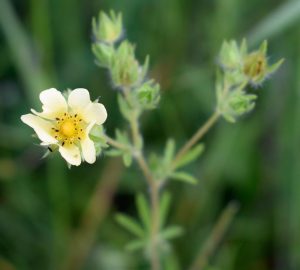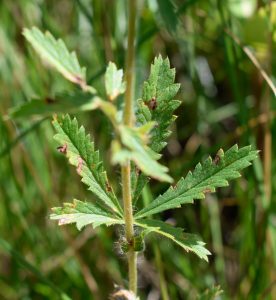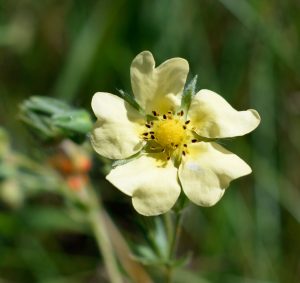Sulphur Cinquefoil
 Potentilla recta, a perennial of European and Asian origin, was introduced in N. America and has now naturalized into the landscape. Like other cinquefoils, it is a member of the Rose family. Sulphur cinquefoil along with its native counterpart, tall cinquefoil (Drymocallis arguta), crops up in their favorite habitats of sunny fields, prairies, along roadsides and edges of woods.
Potentilla recta, a perennial of European and Asian origin, was introduced in N. America and has now naturalized into the landscape. Like other cinquefoils, it is a member of the Rose family. Sulphur cinquefoil along with its native counterpart, tall cinquefoil (Drymocallis arguta), crops up in their favorite habitats of sunny fields, prairies, along roadsides and edges of woods.
June through August, look for sulphur cinquefoil’s tell-tale five petals, so sweetly heart-shaped at their outer edges, pale yellow with a sunny yellow center. The green flower sepals peek in between each petal. Leaves are an easy way to ID this plant as well, for they are palmately compound in groups of 3 to 7, narrow at up to 1″ wide, deeply toothed, and hairy. Stems are distinctly hairy as well. The flower cluster forms at the tip of the rather tall stem.
Observe the very pale yellow flower petals of sulphur cinquefoil as opposed to tall cinquefoil’s white ones — a good way to distinguish between the native and nonnative of this genus. Look also to the palmate leaves of sulphur cinquefoil; these are much narrower (up to 1″ wide) contrasting with the wider leaves (up to 2″ wide) of its native counterpart. Additionally, the leaf arrangement of both species differs greatly. (Palmate leaves are made up of leaflets radiating outward from a central stem likes spokes of a bicycle or a hand with fingers radiating outward from the palm.)


The flower releases no floral scent, but it does produce pollen and nectar — as do all the cinquefoils — attracting numerous insect species into their midst. As the fertilized flower ripens into fruit, the sepals eventually dry and close up protectively around the brown seeded treasure formed inside.
